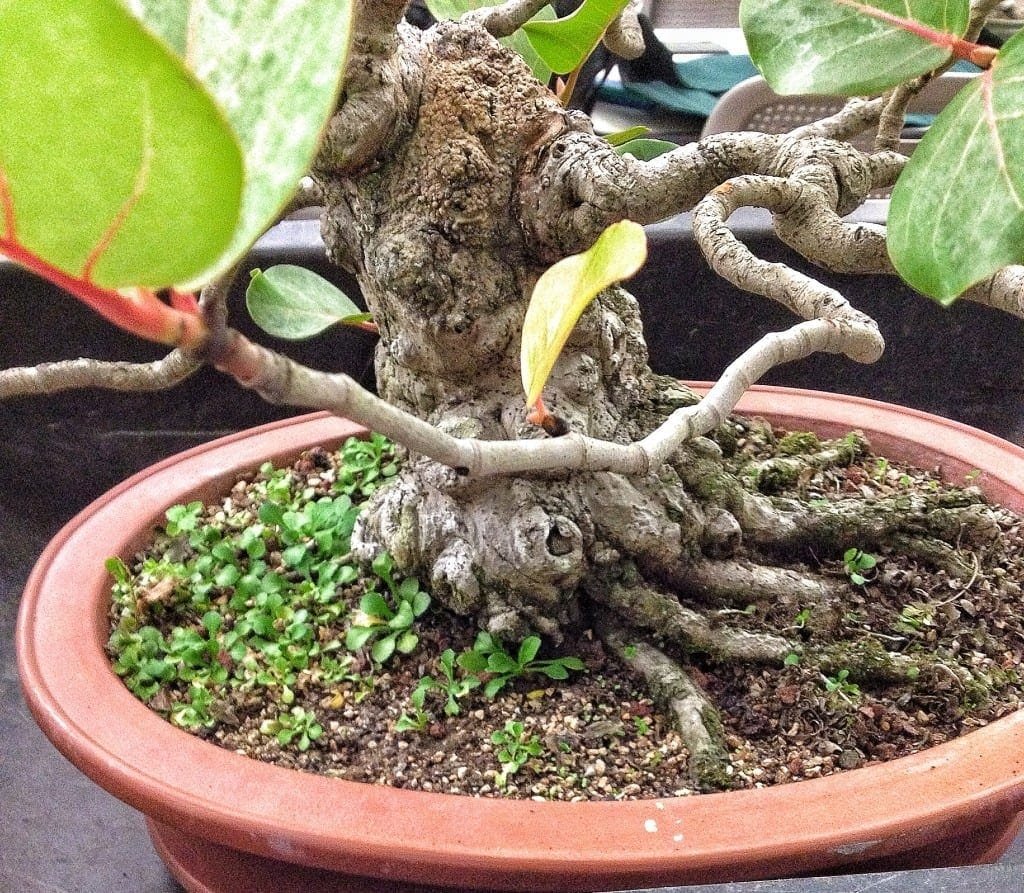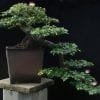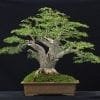When you hear the term Bonsai tree, you probably think about the small, miniature trees that are grown in little containers and are popular in Japanese culture. However, there are actually different types of bonsai and some of these are much bigger than the little tiny ones you think of commonly.
This tree comes in both the smaller variety suitable to make into a bonsai version, or if it is left alone or found growing out in the wild, it will become a much larger tree. It is common and can be found on beaches, where it sometimes forms as a shrub like tree.
| Scientific/Botanical Name | Coccoloba uvifera |
| Description | Sea grape is a flowering evergreen tree that belongs to the same family as buckwheat. The leaves are leathery and round, with red veining. As the leave mature, the veining causes the leaves to redden. The tree is indigenous to parts of Southern and Central America and the Caribbean. The tree also grows in the Bahamas and the U.S. state of Florida. When it is grown outside in its natural habitat, it produces edible fruit that are similar to grapes. Very rarely will it produce fruit when grown indoors. It undergoes a period of dormancy each year that is vital to optimal tree health. |
| Position | Grow the tree in filtered sunlight, and in tropical zones if grown outdoors. |
| Watering | Water the tree regularly to keep soil most, but definitely not waterlogged. Soggy soil can be fatal to the tree. |
| Feeding | Apply fertilizer consistently every two weeks. A soluble, organic fertilizer ensures the most successful growth and flowering. |
| Leaf and Branch Pruning | Continual pruning throughout the growing season will maintain the desired shape. Cut back non-fruit-bearing branches to only two remaining leaves to encourage fullest growth. |
| Re-potting & Growing Medium | Re-pot the tree every other year, at which time it is necessary to reduce the root ball by one-third. Select a container that allows room for root growth and expansion. Re-pot using soil that provides excellent drainage. |
| Wiring | The tree branches respond tolerably well to wiring. However, wiring could dig into the trunk or branches because of the trees fast growth rate. As a protective measure, small bits of foam or rubber may be placed between the trunk/branch and the wire. Alternately, wires could be run through a plastic casing. |
| Notes | If left untrained, the plant will grow upward until it reaches a point where it will hang down. If it is allowed to grow over 36 inches, staking will become necessary. |
Sea Grape Bonsai Tree – Coccoloba uvifera
The Sea Grape Bonsai Tree or Coccoloba uvifera is from the buckwheat family and is considered to be an evergreen flowering tree (link to evergreen trees page) with ivory colored flowers. It has round, leathery leaves that have a red vein running through the base of the leaves. It can be cultivated by planting seeds or by cloning.
This vein causes the leaf to turn red as it ages. It also has a smooth, yellow hued bark and grows a purple, grape-like fruit that can be eaten. However, it rarely produces fruit when it is grown indoors. If you do get fruit from it, you can make it into jelly or jam if desired or eat it raw.
It is native to the Caribbean and other sections of Central and Southern America, as well as growing in Florida and the Bahamas. It can be grown outdoors as well, but only in warm climates such as these.
How To Care
It grows very slowly and also needs to be kept in a warm area with plenty of sun for best results. However, don’t sit the plant in direct sunlight, as it is best if the source of sun is filtered. Its soil should be kept moist and it needs to be watered regularly. But be sure not to give it too much water so it won’t die.
This tree also needs to be fertilized once every 14 days, and an organic and soluble plant food gives the best results. It also needs to be pruned as it grows to keep it shaped properly. Look for branches that don’t have any of the fruit growing on them and cut off right above the very last two leaves so that you will encourage it to grow more.
It should be repotted about once every two years to keep it healthy. When this is done, you also need to cut off about a third of the root ball and then make sure to repot it into soil that has been well drained. Be sure to choose a container with enough room for the plant to continue to grow and expand.
This tree normally goes dormant part of the year, but you should let it grow anyway. This usually happens in the wintertime. However, you should still prune it down to just two buds, and it must be kept out of the cold. This dormant time is important to the overall growth and development of the tree.
If you don’t do any training to make it grow into a certain shape, it will continue to grow upwards and could get so tall that it will bend over. If you let it get to three feet tall, it will need to be staked. It rarely has any pest problem, so you probably won’t have to use any pesticides on your bonsai.
How To Clone
It isn’t hard to clone this tree. Cloning is using a part of another plant to grow a new one. In this case, the roots take a while to start growing, but afterwards they grow quite well and can grow an inch or more a day.
For cloning, you should get a small plastic cup and poke little holes into the bottom and fill halfway with potting soil. Then, choose a small branch of another Sea Grape tree and cut it off a two to four inch section and take off all but the two leaves closest to the top. Then, put this section of the branch halfway down inside the cup. Be sure to keep the cutting moist and be patient, as it can take a month or longer for the roots to start to grow.
If you don’t want to bother with getting your tree in this manner, you can easily order already started trees of various sizes online or buy them in special tree nurseries. You can also order seeds and grow your own from scratch if desired.
Uses
If you are into Feng Shui, the Sea Grape Bonsai Tree is said to promote a calm environment, as well as contribute to the good flow of love energies and bring that love to the person who sleeps in the room where the tree is kept.
For more practical uses, the sap of this tree is used in the West Indies and in Jamaica to dye and tan material. As stated earlier, the grapes can be eaten, but they have a very bitter taste and are best as jelly or jam, or it can also be made into wine.
The wood of large sized trees is also used for making furniture or as firewood. These larger versions of this variety of tree can grow in excess of 30 feet tall.
This tree is said to be a great starter tree for someone getting into raising bonsai type trees since it is a very hardy variety of tree. It produces a pretty tree with red, green and white coloring from the branches, leaves and flowers. It can be a great addition to your home garden and the fruit will also attract birds or other wildlife.


